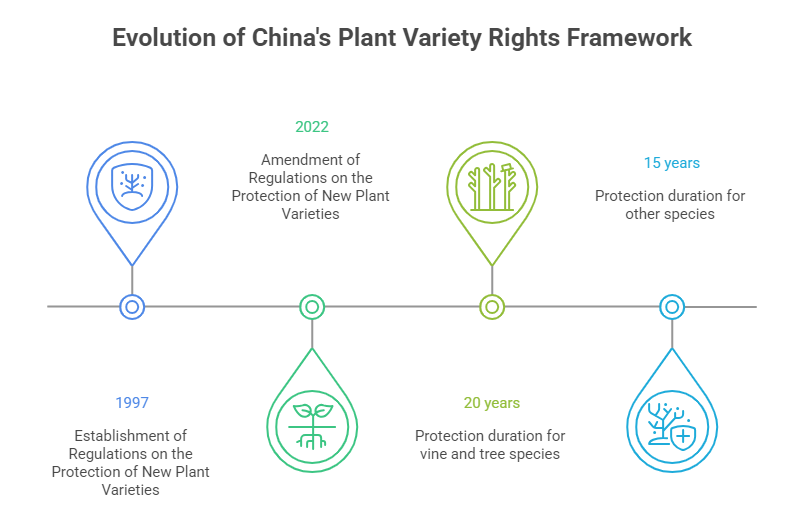For global seed companies and agribusinesses investing in China, protecting novel plant varieties isn’t just about biology – it’s about navigating a sophisticated legal landscape. China’s Plant Variety Rights (PVR) system, formally known as “New Plant Variety Rights” (NPVR), grants breeders exclusive commercial rights, mirroring patents for mechanical or chemical inventions. Understanding and verifying these rights is paramount for mitigating risk and securing your agricultural investments.

The Bedrock: China’s PVR Framework
Established under the Regulations on the Protection of New Plant Varieties (1997, amended 2022) and administered by the Ministry of Agriculture and Rural Affairs (MARA) and the National Forestry and Grassland Administration (NFGA), China’s PVR system grants breeders exclusive rights to produce, sell, and market the propagating material (seeds, cuttings, tubers, etc.) of their novel varieties for a defined period.
- Protected Varieties: Crops, forest trees, fruit trees, ornamental plants, and forages listed in China’s protected plant genera and species catalogues.
- Core Requirements (The DUS Test): To qualify, a variety must demonstrate Distinctness (clearly different from existing varieties), Uniformity (consistent characteristics), and Stability (traits remain unchanged through propagation).
- Protection Duration:
- Vine and tree species: 20 years from grant date.
- Other species (e.g., field crops, vegetables): 15 years from grant date.
- Exclusive Rights: The PVR holder controls the production, reproduction (propagation), conditioning (cleaning, grading), offering for sale, selling, exporting, importing, and stocking of the protected variety’s propagating material. Unauthorized commercial exploitation constitutes infringement.
Why PVR Verification is Non-Negotiable for Agribusiness
- Assessing Market Freedom to Operate (FTO): Before launching a new variety or sourcing seeds in China, due diligence is critical. Is the variety you plan to use protected? Who holds the rights? Verification prevents costly infringement lawsuits and market withdrawals.
- Evaluating Partnership & Investment Risks: When collaborating with Chinese seed producers, investing in local breeding programs, or acquiring companies, verifying PVR ownership and validity is essential. It ensures the assets you’re relying on are legally sound and enforceable.
- Identifying Infringement & Protecting Your Own Rights: If you suspect your protected variety is being illegally propagated or sold in China, the first step is verifying the registration details and gathering concrete evidence. Conversely, verifying others’ rights prevents you from inadvertently infringing.
- Understanding the Competitive Landscape: Knowing which varieties are protected and by whom provides crucial intelligence on market dynamics, competitor strategies, and potential licensing opportunities.
How to Verify China Plant Variety Rights: Navigating the Sources
Verification involves accessing official databases and documents, which can present hurdles for international businesses:
- China New Plant Variety Protection Database:
- Managed by: MARA’s Science and Technology Development Center (Primary for agricultural plants).
- Access: Publicly searchable online database (Chinese language interface predominates). Searchable by variety name, applicant/holder name, species, application/grant number, and date ranges.
- Information Provided: Application number, variety name (Chinese), Latin name, species, applicant name, applicant address (often limited detail), breeder name, application date, publication date, grant date, duration, status (application published, granted, terminated, expired), and importantly, the “Grant Announcement” document number.
- Official Gazettes and Grant Announcements:
- Source: MARA publishes official announcements detailing granted PVRs, including the full scope of protection and the DUS test report summary.
- Importance: The Grant Announcement is the definitive legal document confirming the rights and their parameters. Accessing the full text often requires specific knowledge or channels.
- PVR Title Certificates: The formal certificate issued to the rights holder by MARA/NFGA. While not publicly searchable, verifying its existence and details is crucial in due diligence for transactions or disputes.
Challenges in Verification & How to Overcome Them
- Language Barrier: Databases and official documents are primarily in Chinese. Names and addresses may be transliterated inconsistently.
- Data Fragmentation: Agricultural varieties are under MARA, forestry under NFGA – requiring checks in potentially different systems.
- Accessing Detailed Documentation: Retrieving full grant announcements or certificates often requires direct requests or specific access.
- Verifying Validity: Checking if annual fees are paid (required to maintain rights) or if rights have been challenged/revoked requires deeper investigation than basic database status.
- Complex Ownership Structures: Identifying the ultimate beneficial owner, especially with holding companies or complex licensing, can be difficult.
Case Study: The Rice Revolution (and Litigation)
Consider a multinational company (“GlobalAgri”) developing a high-yield rice variety. Before commercial launch in China, they discover a remarkably similar variety already being marketed by a local competitor (“ChinaSeed”). GlobalAgri suspects infringement of their own international PVRs.
- Step 1 – Verification: GlobalAgri needs to urgently verify:
- Is the competitor’s variety officially granted PVR protection in China? (Search MARA database).
- What is the exact scope of protection granted? (Obtain Grant Announcement).
- Who is the recorded rights holder? Is it ChinaSeed or a licensor? (Database + potential deeper investigation).
- What are the DUS characteristics of the protected variety? (DUS report summary in Grant Announcement).
- Are the rights still valid? (Check status and fee payment history – requires deeper access).
- Step 2 – Analysis: Comparing the DUS characteristics of GlobalAgri’s variety and the Chinese protected variety is crucial evidence for potential infringement litigation or invalidation proceedings against the Chinese PVR.
- Step 3 – Action: Armed with verified information and official documentation, GlobalAgri can engage legal counsel for enforcement or defense with a solid factual foundation. Without this verified data, their legal position is significantly weaker.
Building a Secure Foundation in China’s Agri-Market
China’s commitment to modernizing its agriculture sector includes strengthening intellectual property protection. Plant Variety Rights are powerful legal assets. For international agricultural enterprises, proactively verifying these rights is not optional diligence; it’s fundamental risk management. Whether ensuring your freedom to operate, securing your investments, protecting your own innovations, or defending against claims, access to accurate and official PVR information is the cornerstone of strategic decision-making in this vital market. Navigating the verification process efficiently often requires specialized knowledge and access to official channels beyond basic online searches.
Ensure your agricultural investments are built on solid legal ground. Verify Chinese Plant Variety Rights accurately and efficiently with professional support. Explore our comprehensive intellectual property verification services to safeguard your agribusiness interests in China. For complex cases requiring official document retrieval, learn more about our company documents retrieval expertise.
